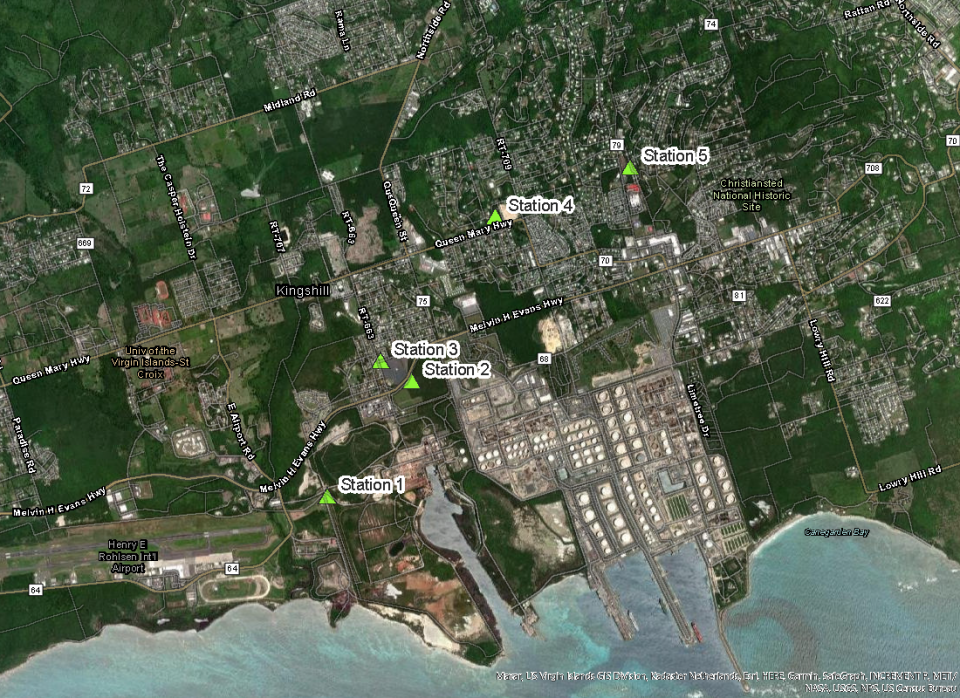Monitoring the Air Near Limetree Bay
After operating five ambient air monitoring stations to measure for both hydrogen sulfide (H2S) and sulfur dioxide (SO2) since May 2021, EPA will transition monitoring activities at these five locations to Limetree Bay. Under a filing in federal court in July, Limetree Bay purchased and installed the same type of air monitoring and telemetry equipment that EPA has been using. Limetree Bay’s monitors have been running side-by-side with EPA’s monitors since October 25, and EPA has confirmed that the monitors being operated by Limetree Bay are producing results consistent with EPA’s monitors.
As planned when EPA’s monitoring began, ambient monitoring will now be conducted using equipment owned and operated by Limetree Bay, and EPA is removing its equipment beginning November 16. EPA will provide continued oversight of Limetree Bay’s ambient air monitoring activities. The results of the monitoring performed by Limetree Bay will be made available to EPA and Limetree Bay simultaneously. EPA experts will regularly look at the monitoring results.
Limetree Bay will implement a monitoring plan that is consistent with EPA’s protocols and the equipment manufacturer’s specifications. EPA has requested that Limetree develop a plan for online posting of ambient air monitoring data. EPA has also requested that Limetree provide specific notifications to EPA and certain USVI agencies, as well as the federal Agency for Toxic Substances and Disease Registry (ATSDR), if there are exceedances of the Tier 1 threshold or higher, if and when hydrocarbon purging activities commence. The planned hydrocarbon purging activities at the refinery are paused indefinitely.
EPA is continuing to communicate regularly with members of the surrounding St. Croix community. EPA established a St. Croix response hotline to respond to and document concerns from affected individuals. Since inception of the toll-free hotline on May 8, 2021, over 300 calls have been received. In addition to responding to community members’ concerns, hotline operators obtained additional information to identify the most impacted geographic regions and characterize the nature of the complaints and odors experienced. With this information, EPA developed an interactive dashboard for visualization of the hotline call data. EPA will continue to maintain the hotline resource to respond to community members’ concerns. The dashboard is updated weekly to reflect any new calls received.
The locations of the five monitoring stations are shown on the map below.

EPA consulted with health experts at the Agency for Toxic Substances and Disease Registry (EPA’s federal counterpart on the health side) and the U.S. Virgin Islands Department of Health (VIDOH) to develop threshold levels to compare data to and to guide the appropriate local agencies in decision-making.
EPA and ATSDR developed the following charts to show the threshold values for both SO2 and H2S.
Data from EPA (as of November 16, 2021)
On an intermittent basis from May 15 to July 13, EPA measured Tier 1 and Tier 2 exceedances for hydrogen sulfide (H2S). EPA had also observed some sewer manholes near Station 1, and these manholes are approximately 200-300 feet from Station 1. Strong sewer gas and H2S odors have been observed near the manholes. The manholes and Station 1 are located on private property with restricted access.
Monitoring for SO2 – Monitors Run by Limetree Bay
If Limetree Bay were to resume operation they would be required to set up EPA-approved Federal Reference or Equivalent Method monitors for SO2. These monitors work by drawing in ambient air through an inlet to an analyzer which uses UV light to determine SO2 concentrations. These monitors would need to be operated in accordance with an EPA approved Quality Assurance Project Plan, which speaks to requirements such as siting equipment and data handling. The data from these monitors would be used to determine if the National Ambient Air Quality Standards (NAAQS) for SO2 are being met. The 1-hour SO2 NAAQS is 75 parts per billion (99th percentile of 1-hour maximum concentration over 3 years). Federal Reference and Equivalent Monitors are the “gold standard” of air pollution monitoring systems and ensure air quality data collected at different sites are gathered in the same manner and are accurate.
What is Sulfur Dioxide?
Sulfur dioxide (SO2) is a nonflammable, colorless gas with a very strong, pungent odor. Most people can detect sulfur dioxide by taste at levels of 0.35 to 1 parts of sulfur dioxide ppm and by smell between 0.67 and 4.75 ppm. Sulfur dioxide is severely irritating to the eyes, mucous membranes, skin, and respiratory tract. Inhalation exposure to very low concentrations of sulfur dioxide can aggravate chronic pulmonary diseases, such as asthma and emphysema. Sulfur dioxide respiratory irritation induces symptoms such as sneezing, sore throat, wheezing, shortness of breath and chest tightness.
What is Hydrogen Sulfide?
Hydrogen sulfide (H2S) is a pollutant that at low concentrations may cause headaches, poor memory, tiredness, and balance problems. Brief exposures to high concentrations of hydrogen sulfide (H2S) can cause loss of consciousness. Hydrogen sulfide is a flammable, colorless gas that smells like rotten eggs. People usually can smell hydrogen sulfide at low concentrations ranging from 0.0005 to 0.3 ppm. At high concentrations, a person might lose their ability to smell it.
